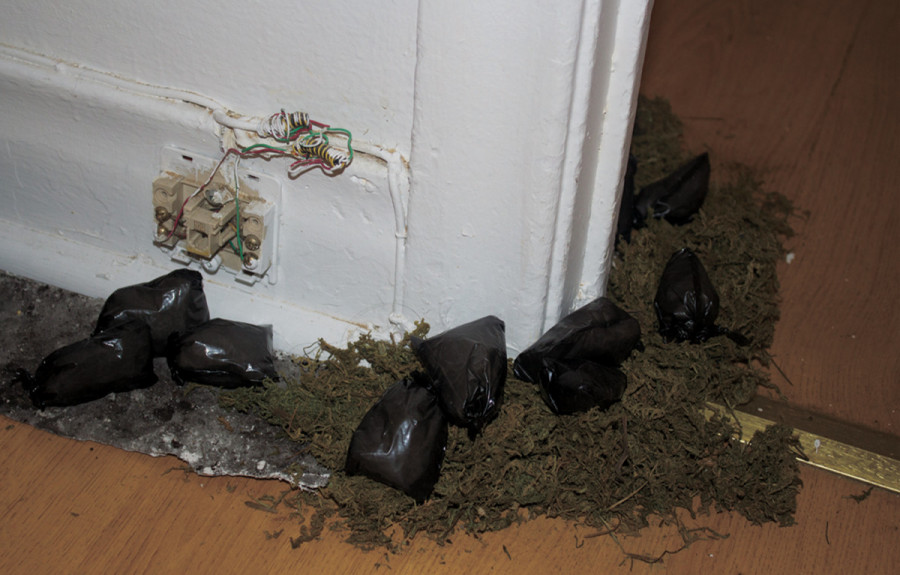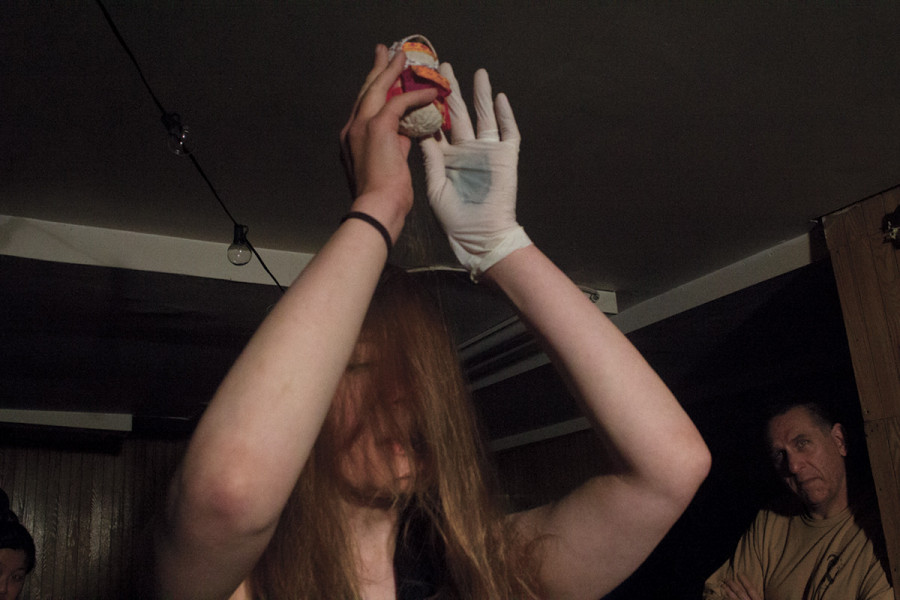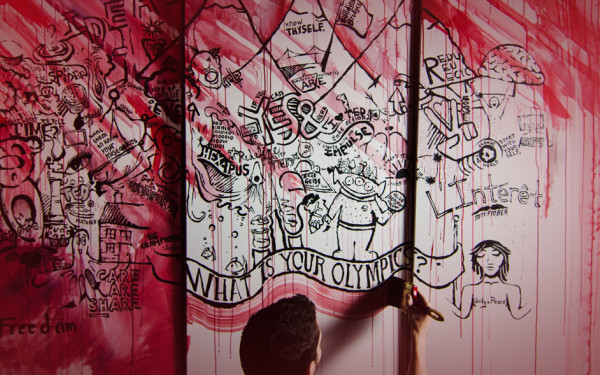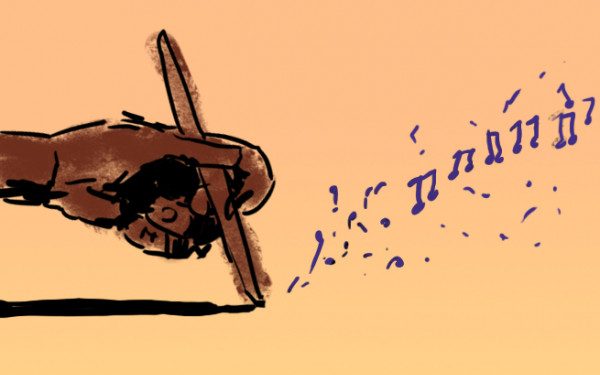Decolonizing Art At Peripheral Hours and Métèque
How Alternative Art Spaces Create a Pathway for Marginalized Voices
It’s hard to find a physical space where [people] can sit down and talk to each other,” said Victoria Catherine Chan, standing among renovations at Peripheral Hours.
The alternative art space, inaugurated by Chan in the fall of 2018, lives in a triplex. It lies tucked in a residential area, between homes in the Chabanel district.
“Because [of] the way contemporary spaces are being built, you’re just going there to consume, but there’s no space for conversation or intimacy, and eventually people don’t have these moments of connection and community,” said Chan.
The space has been under renovations for the past four months. Once the work is done, Peripheral Hours will come to life once again. The space advocates for and invites BIPOC (Black, Indigenous, People of Colour) and queer artists to make and exhibit their art, one of the few art spaces in the city where minority groups are actively encouraged and supported to stretch their practice as far as it can go.
It is difficult for marginalized artists to find space and representation in the contemporary art world, explained Chan.
Creating Peripheral Hours is about reclaiming a space, she explained, and reclaiming power in a society that does not always reflect her. She says it is a form of self-empowerment.
Born in Montreal to Chinese immigrant parents in the era of Bill 101, Chan said she has always been questioning her identity.
She spent her childhood assimilating and integrating with Quebec’s francophone culture. She learned to navigate the realms of identity politics that strike the province and learned to speak the language. Blending into the landscape, she molded herself into a “Quebecer.”
Feeling “sucked in with a collective identity,” Chan’s young adult years had her itching for a change.
“I wanted to make art. But I was not given [the] opportunity,” she said. “I was not given the support to express myself creatively, to have an artistic voice.”
With immigrant parents who did not support her dreams of becoming an artist, a lack of representation in contemporary art, and a lack of spaces that invite and support marginalized artists, Chan felt stuck.
The white walls of an institution are beneficial to some, but for others—especially marginalized voices in Quebec—they can be stifling. A lack of representation means many artists—including Chan—don’t find themselves with an opportunity to flourish.
A “whitewashing” of the art world leaves POC and immigrant artists at a loss. A lack of discourse about the province’s—and the country’s—colonial history doesn’t allow for true symbiosis of culture. “The system is actually very racialized—it’s systematic racism that has been ingrained in our colonial culture for 500 years,” said Chan.
“What does it mean that we have not been informed and taught history classes about the wrongs that have been committed by the European settlers? What does it mean that we are living on an occupied territory, and it’s actually an unceded territory?” she continued.

“I have been colonized all my life. I have to now decolonize myself for the rest of my life.” — Victoria Catherine Chan
“Quebec is very closed in terms of gallery space, exhibition space for immigrant artists, and most of them experience rejection constantly,” said Carolina Echeverria of Métèque, an atelier and workshop dedicated to representing a diversity of artists.
Nestled in Notre-Dame-de-Grâce, Métèque has been focusing on fostering relationships between Indigenous Peoples and “immigrants,” a term Echeverria means to describe “people who came here yesterday, and people who came here 200 years ago.”
In its third year of existence, Métèque also provides a space for BIPOC and immigrant artists who have had trouble breaking into the local art scene.
“There’s a very perverse hiding of the story that this land is about, especially to immigrants,” said Echeverria. “You think you’re coming to Canada, but it’s Quebec, then you think you’re in Quebec, but really it’s Native land.”
Echeverria, a Chilean immigrant of 33 years, said it took her 23 years to learn she was on Indigenous land.
“Once I understood this was Indigenous land, I thought, well, I have more in common with Indigenous people here than with the Canadian nation,” she said. “As an immigrant, I understand being displaced. I understand loss of language, I understand lost culture, I understand being a minority, I understand not being treated very well.”
As part of the wave of Latinx immigration in the 1970s, Echeverria said that her experience as a newcomer in Quebec was a positive one. Now, however, she says things have changed.
“There’s a growing racism and fear,” she said. “Having said that, I felt like the national portrait of who we are as a society is so outdated. It’s not going to look the way it looked before when everyone was super White, or British, or French.”
The idea to start Native Immigrant, the not-for-profit project behind the atelier, came to Echeverria back in 2013. “I come from a country that is also colonized. So, you don’t want to leave something to come and become part of the problem when you’ve already suffered that.”
The atelier hosts workshops and showcases the work of both Indigenous and non-Indigenous artists. The space is striking in its colour—bright portraits line the walls, dresses full of patches and beadwork catch the attention of people passing by the window. A table full of beads lies in the center, shiney and glimmering.
“We are Indigenous-focused,” explained artist and workshopper Martin Akwiranoron Loft. “Being a printmaker myself, my portion of it will be on fostering an Indigenous space where Indigenous artists can make work.”
Though the atelier focuses on giving space to Indigenous artists, it’s not exclusive, he said. In the upcoming months, Loft will be leading printmaking workshops from a printing press.
The Kanien’kehá:ka, or Mohawk, artist has been involved with Métèque for the past year and a half. A studio like this, that offers opportunities for Indigenous artists, has been long awaited in the community, according to Loft. Though a small step, he said, it’s an important one.
Peripheral Hours is striving towards the same goal of cultural diversity and inclusion.
In the fall of 2018, Chan made a spur-of-the-moment decision to host a pop-up exhibition in the house she manages. A mere three weeks after her strike of inspiration, Peripheral Hours was born. A “conceptual location, a space in our collective imaginary,” according to Chan, the space was designed to create an immersive environment that would blend the worlds of art and domesticity to explore identity in a safe space.
The triplex had been in her family for over three decades. She was inspired by the alternative art spaces in Europe and in New York City, where she lived and worked during a ten-year artistic exploration journey.
“Being abroad and in a foreign land, for me, it was a neutral environment,” said Chan. “Within that, I discovered a part of my identity and individuality far away from the Quebec identity politics.”
Creating Peripheral Hours, a space that embraces and encourages meaningful dialogue, is part of Chan’s personal healing and journey to self-discovery. “I’m taking root,” she explained, “and I want to reclaim my identity.”
From improvisational sculptures created on the spot with found objects, video montages screened against a bedroom wall, to bright paintings tucked neatly into hidden closet spaces, the first exhibition space brought 38 artists, many of whom were international BIPOC artists based in Montreal.
Spaces like Peripheral Hours are integral for immigrants new to Montreal, according to Jin Heewoong, an installation artist who recently moved to Montreal from Korea. Heewoong showed his installation pieces at the first exhibition, which took place on Oct. 4, 2018.
Struggling to find a network in a new city, Heewoong felt exhibiting his work at Peripheral Hours led him to meet local artists. “We are trying to build up a community of our own,” he said.
Aiming to flesh out the truth behind colonization, Chan seeks to create a space where this narrative is explored through workshops, exhibitions, and intentional conversation among artists.
Colonialist patterns are part of the modern Quebec culture and are perpetuated within the society. More than just a one-time event, colonization is ongoing and systematic. “We live in a time of reconciliation,” explained Chan. “For me, it matters to decolonize art history, contemporary art, and our bodies. Our way of living and our way of being with the others. That’s the first step.” my life,” she added. “I have to now decolonize myself for the rest of my life.”
“I have been colonized all my life,” she added. “I have to now decolonize myself for the rest of my life.”


_600_832_s.png)


_600_375_90_s_c1.jpg)

